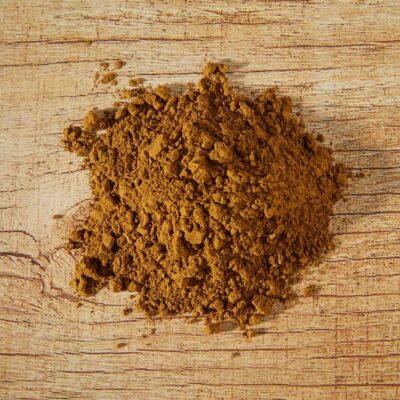Description
Inorganic pigment
For more information
530 Vaalea Rautaoksidiruskea
Light iron oxide brown pigment.
Pigments
Pigments, or color powders, are suitable for paint tinting and manufacturing, decorative and art paintings such as marbling, waiting, patinating, and concrete, lime mortar and lime paint. A binder is added to the pigments, which binds the paint and holds it on the surface to be painted. Pigments can also dye gypsum, paper and cardboard. The result of the color depends on the amount of the pigment used and the binder used.
Ground pigments
Pigments can be found in ground colors such as ocrats, terraces and umbrats are natural pigments from nature, which are very well suited for use in oil paints due to their light resistance and color. Umbrats are iron oxides that are rich in manganese. The pigment is durable and has excellent light resistance. Umbrats are not toxic pigments. They can be combined with other pigments and are suitable for all binders. Iron oxide pigments are suitable for tinting concrete and mortar because of their good coloring. Genuine color pigments provide beautiful and soft colors.
Aptitude
Light resistance: Good
Water -based binders: good
Oil -based binders: good
Lime and cement: good
The use of pigments to tint the paint
In tinting water -borne paints, it is advisable to first mix the pigment into a small amount of water to provide so -called. Tinting pasta. The pigment is mixed with the water so that the paste becomes smooth and fairly thick. The prepared paste is added to the paint until it is the shades of the desired. The proportion of the pigment should not be more than 10% in the finished paint, as too much pigment increase reduces the ability of the paint to grab its substrate and the paint may stain even as dry. Thus, white paint does not get very dark shades. The binder levels of different paints vary, so the tinting is always paint -specific. In the tinting of oil paints, the principle is the same as tinting water -borne paints, but the pigment is first mixed with either turpentine or cooked linseed oil ( in his verno ).
530 light iron oxide brown in paint making
Pigmented oil paint for indoor use. (about 1 liter)
Homemade oil paint is suitable for furniture painting and oil glass production. Changing the number of pigments can affect the paint coverage.
5 dl cooked linseed oil
1 dl general
about 500-700g pigmented, depending on the color
0.5 dl serotine
The ingredients are measured, for example, in a three -liter container and mixed heavily with a paint mixer attached to the drill, depending on the roughness of about 15-60 minutes of pigments. Finally, the paint can be filtered so that the insoluble pigment rocks are removed. If the paint feels too thin, you can thicken it by adding chalk flour as needed. Different pigments react differently; Some need more oil to dissolve than others. Usually heavy pigments dissolve in a smaller amount of oil than light dusting pigments. When making small batches, the pigments dissolve in a smaller amount of oil than light dusting pigments.
Pigmentation of the pigmentation
When making a paintbotter, it is important to rub. Pigments can be rubbed with the oil with a pigment mass or a palette knife on top of a glass. Initially, the paint rushes against the platform. The paint is ready when the mixture is smooth. Masses just a little paint at a time. Mix more oil in the paste and the paint is ready. The paint is brushed in thin layers 2-5 times. Allow the surface to dry between the layers for 2-5 days.





